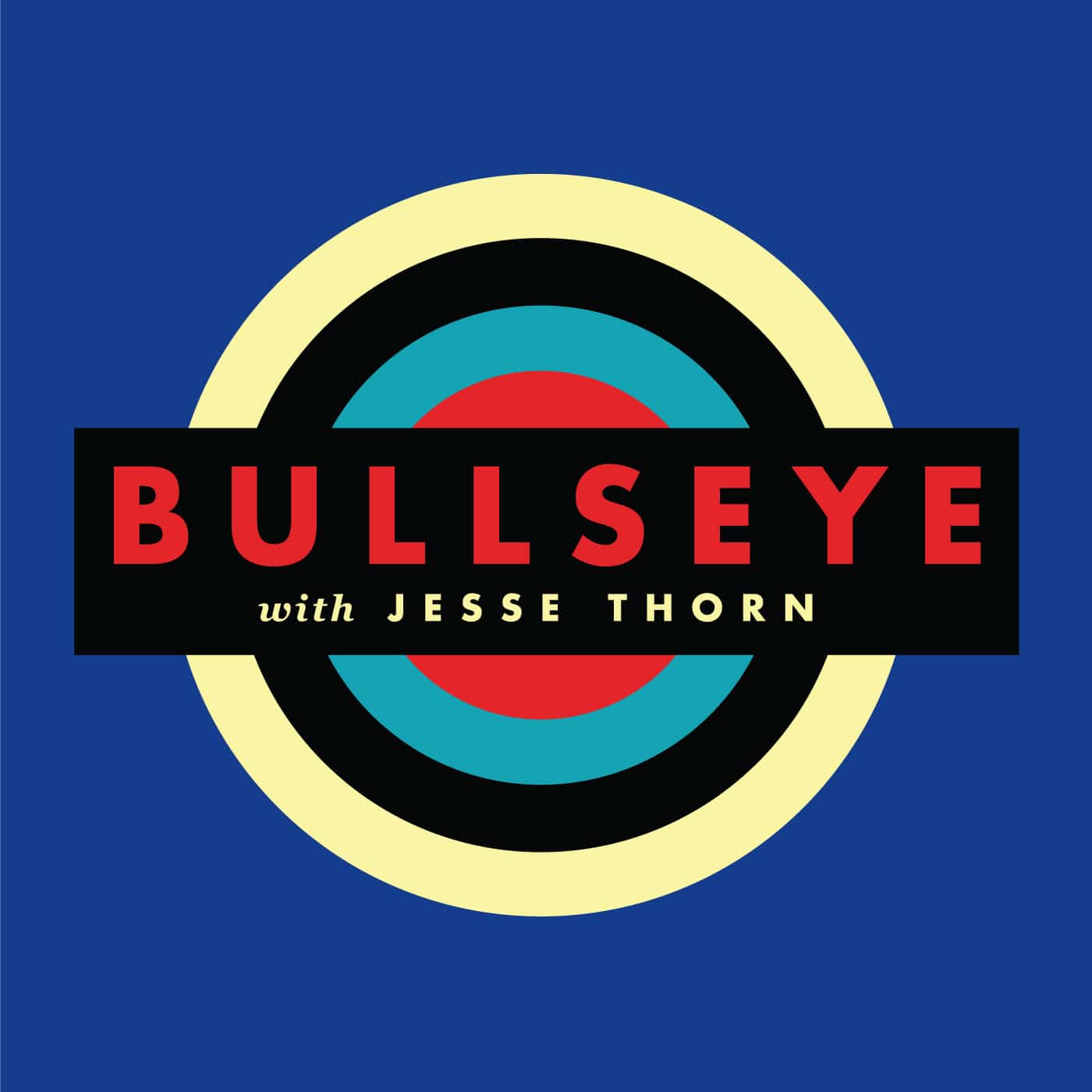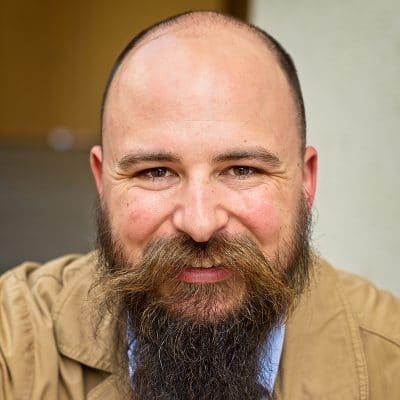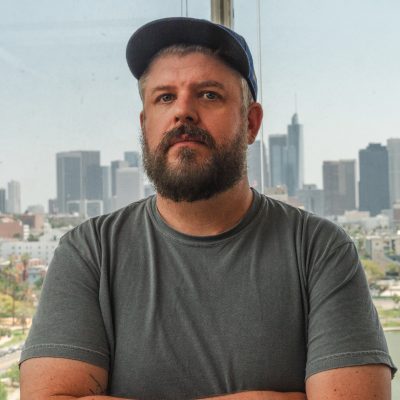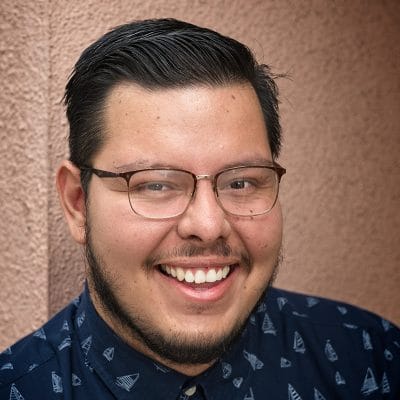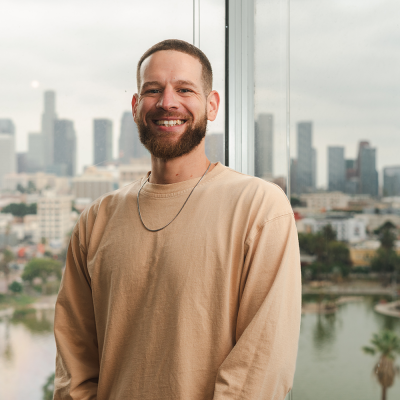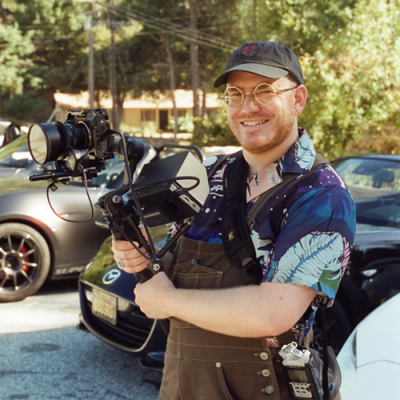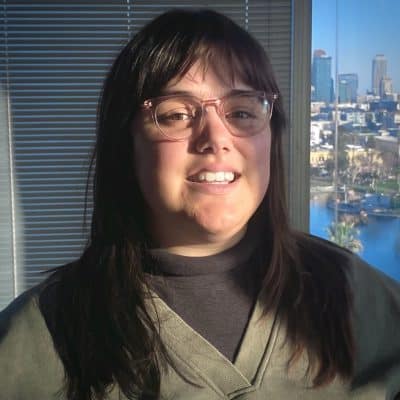Transcript

music
Gentle, trilling music with a steady drumbeat plays under the dialogue.

promo
Speaker: Bullseye with Jesse Thorn is a production of MaximumFun.org and is distributed by NPR. [Music fades out.]

jesse thorn
I’m Jesse Thorn. It’s Bullseye.

music
“Huddle Formation” from the album Thunder, Lightning, Strike by The Go! Team. A fast, upbeat, peppy song. Music plays as Jesse speaks, then fades out.

jesse
Mary Randolph Carter—or Carter, as she prefers to be known—has worked high up at Ralph Lauren for decades. She’s a creative director there. That’s her day job. In her free time, she collects stuff. She calls it junk, and she has a lot of junk. In her apartment in New York, where she and her family have lived for decades, her walls are filled with old pictures, portraits, photos, still-lifes, that kind of thing. She stacks books under desks, along the walls, sometimes just in the middle of the floor. If you’re sitting on her sofa with a drink, your best bet is probably to hold onto it. More often than not, her coffee table—which almost certainly is an antique—is covered in vases and little sculptures and probably a bunch more books. Always more books. Does her place look busy? Yes. A little. But it doesn’t look cluttered. It’s deliberate. It’s thoughtful. It’s welcoming. It’s warm. Everything in it has a story. Maybe the goofy looking bird knickknack on the shelf over there is something she picked up on a road trip, ten years ago. Or maybe the portrait in the living room reminds her of a relative that she lost years ago, even though she bought it at a swap meet, in Queens. It’s all junk, like she says. But that doesn’t mean it’s worthless. It’s what makes her home her home. She’s written a handful of books about junk, photos of flea markets, guides to antique stores, design inspiration, and a philosophy of design so articulate and simple she summarizes it in her book titles. Like, A Perfectly Kept House is the Sign of a Misspent Life. Or Never Stop to Think Do I Have a Place for This. And in her latest book, The Joy of Junk: Go Right Ahead, Fall in Love with the Wackiest Things, Find the Worth in the Worthless, Rescue and Recycle the Curious Objects that Give Life and Happiness. We’re replaying my interview with her from a couple years ago because, I don’t know, maybe you’re still stuck at home. Maybe you’re trying to get organized and clean up. Maybe you’re wondering what of your stuff sparks joy and what doesn’t. And Carter’s answer to that question might be, “What if it’s okay if all of it sparks joy?” [Music fades in.] Anyway. Let’s get into the interview.

music
Thumpy, relaxed, jazzy music.

jesse
Carter, welcome to Bullseye. It’s great to have you on the show.

mary randolph carter
Well, thank you Jesse. I’m really very happy to be here.

jesse
You grew up in Richmond, Virginia. Did you grow up in a house full of stuff?

carter
Hm. I have to think about that. It was certainly a house full of children and people. And I guess we had a lot of stuff, too. Yes. I would say we had a lot of stuff. But not as much as we had later, when we left Richmond. [Chuckles.]

jesse
How did you think about your home? Like, was it totally transparent to you or did you think of it as a special place?

carter
Oh, totally a special place. It was—you know, it’s funny because I’ve lived in New York longer than I lived in Richmond or in Virginia. And still, when we go to Virginia—which is where my—I always say we’re going home. And my husband says, “No, but that’s not your home.” But someplace in my heart and bones, it’s still home. So, yes, it was a very special place, because of—because of the people and the stuff and the dogs and the cats and the parakeet, Ernie, that I had. But I left Richmond when I was probably around 12 years old. So. And moved down to the northern neck of Virginia. The Tidewater area, on the Chesapeake Bay and the Rappahannock River. And I think—so my homes are kind of split. But Richmond was where I was born and where I—you know, lived until I was 12. And maybe—maybe furnishing that little dollhouse that I had, up on the third floor, was where that junker streak began. When I was looking for those odd things to make it special for my dolls. We left that home… rather unexpectedly, because we had a very tragic fire, one night. And lost three of my family. So, eventually we actually—I wouldn’t say fled, but the memories for mother particularly—she lost her father and her great aunt and her aunt and her sister—were too much to bear. And so, we moved to the Tidewater area, where we had lived in a funny old barn, in the summertime. And we started our lives over, down there, and created a new home for ourselves.

jesse
Did having that experience of having that tragic fire change your relationship with home and with stuff?

carter
Certainly, with stuff. I think you learned that even though someone kindly found my—one of my dolls or actually, I think, a teddy bear that was saved… yes. Of course. We lost—we lost the things that were important to us, and all the other things didn’t matter. And then I guess I have to share with—I don’t know why I’m taking you through… the tragedies of my young life, but then when we moved to Whitestone into this—into River Barn, was the name of our house. When I was 16, which would have been about three and half or four years later, we had another fire. [Chuckles.] And at this time, we were all saved—meaning my mother and father and my two brothers and sisters. Or, they were—there are nine of us. We lost our dog, who went back in to find my father. But the next day, when I walked over, it was a big sandpile of ashes. So, we really lost everything. But, we didn’t. Because that night, when we stood there counting each other over and over again, to see if we had—if we were all there, there was one sister missing and then we realized that she had gone to an overnight party. We were all saved. And all the stuff—the books, the paintings, the photographs, everything was gone.

jesse
You know, I’ve seen pictures of your apartment, in New York. [Carter chuckles.] And your home, in New York State. [She affirms.] And, you know, in your apartment, there is—there’s hardly an inch of wall that isn’t covered with [chuckles]—that isn’t covered with a painting or something else. And I wonder if that was always the way that your home looked. I mean, like, once you had your own house—was it always—was it always chockablock?

carter
Well, it took time! You know. I’m very old and I’ve been collecting for many years. So, you know, the thing is—I mean, when I moved to New York and had my first, you know, five floor walkup studio apartment, I brought with me things from Virginia—from my home. Like a blue painted rocking chair, a few old quilts, a sampler to put on the wall. Things that were kind of totems, I suppose, of that life that I loved, but couldn’t wait [laughing] to get away from. I was destined to come to the city for a long time. But I still wanted to create the environment—obviously you know this by looking at those pictures—the environment that I place myself in and that I’ve create for me and for my family, eventually. Everything is—it’s very, very, very important to me. So, to start off in that apartment, I needed things that I could relate to and made me feel comfortable and were a thread to the life. And so—so, slowly, yes. I mean, it was easy to cover the walls in a studio apartment. But I think that, yeah, every place that we’ve lived in, we’ve lived—you know, we’ve lived in the apartment, which is not—it’s kind of strange for urban dwellers, but we’ve lived in the same apartment for… like, four decades.

jesse
I mean, I think the real question that all of us who want to acquire furniture and things to put on the walls face is: where do you put a television? [Chuckling.] Like, is—is there something you can put in front of the television?

carter
That is something, yes, that we all have—we’ve all had to deal with and… particularly when the TV sets started getting bigger and bigger, you know? These wide screen, whatever you call them.

jesse
Or a flatscreen, sure.

carter
Flatscreen! Okay, the big flatscreen. Well, this is—this is the—this is the most wonderful, serendipitous moment. I’d gone into this—let’s say this is two years ago. And they were shopping, my husband was shopping for this big flatscreen to put in the country house. And I was like, [mournfully] “Oh! No! No, you can’t disassemble my beautiful little… front parlor.” But anyway—and so, I happened, at the same—the same moment that he was doing that, I was hunting down a cupboard. Well, I wasn’t hunting for it, but it stood in front of me—this big, beautiful, blue cupboard. And I bought it, not thinking about where it would go or what would go in it. But guess what fit perfectly in it? The flatscreen TV! And then I surrounded it with all kinds of [with a French accent] object and books. There have been times when I have, you know, actually put, like, an old quilt on top of the—of the flatscreen, but… no. I’m living with it, now. [Jesse laughs.] But that was just so incredible! My desire for this—for this cupboard and my husband’s desire for the flatscreen, they met. And married. And are living happily ever after, in the front parlor of our room that used to be called the purposeless room, because it really didn’t have a purpose. I mean, my husband would say, “What is this room? It’s not a TV room, it’s not a dining room.” I said, “Well, originally it was the front parlor.” And we—then we put his mother’s baby grand, we stuffed that in the corner. And then I said, “Well, we can call it the music room.” But eventually, now it’s the TV room.

jesse
How did you end up becoming a junker? Because I don’t imagine that there’s a huge volume of junkers in the New York City magazine business, where you cut your teeth for a couple of decades. New York is a hard place to be a junker, ‘cause you kinda gotta go somewhere to get the space to have a flea market.

carter
Well, that’s true. But you forget about junking on the city streets. I mean, it is a gold mine, out there. I mean, I find things all the time. So, it’s not just—and the New Yorkers—the dealers are very clever. They take weekend parking lots that are abandoned for the weekend and they turn them into flea markets. But I will tell you, it’s harder and harder to find those places. But, oh, junk is alive and well in New York City, for sure. I have evidence of it in this book!

jesse
Do you have a favorite junk store? One of your old books had a directory of junk stores by location. And—

carter
Mm-hm. By state, or—yeah.

jesse
And I was looking through it and I saw this shop called Krims-Krams. It was—[laughs.]

carter
Oh my gosh! Yes. In San Francisco!

jesse
Yeah, exactly! It was right near where I grew up. [Carter makes a sound of soft surprise.] And this book came out, I guess, in maybe 1990 or something like that. So, I—that was probably around when it ended up closing. But I had the most immediate, vivid flashes of memory of being, you know, an 8-year-old and going there and buying a lunch box.

carter
[Surprised.] Really?!

jesse
And borrowing 20 cents—I cost 20 cents. They told me it cost 20 cents. So, I went home, to my house—my apartment, and—my mom’s apartment—and got my mom to give me two dimes so that I could—this is like a story from 1952, but it was like 1989—to get this Super Friends lunchbox at Krims-Krams. Yeah, I grew up two blocks from that store and thought, like, “What an incredible, like, vivid part of my life that store was.” And I wonder if there were stores like that, for you.

carter
Well, certainly in—I mean, I remember Krims-Kram or whatever it was called. What a great name. I mean, I was doing Big City Junk. Uh, no, I wasn’t. I was doing Kitchen Junk, which was my… third book in the—my version of the Alexandrian quartette. [They laugh.] There was American Junk and then there was Garden Junk and then there was Kitchen Junk and Big City Junk, which was published a week after 9/11. How ironic was that? But anyway, I was—you know, I was—I was going from city to city and looking for great, you know, junk and Krim-Krams I remember had great kitchen artifacts. It was a great store. But do I have—I’ve always—yeah! There—I have—I have favorites, you know. Part of it—part of this whole journey, part of it’s nostalgic. And so, when I think about some of my favorite stores or junking journeys or jaunts, it was with my mother—who really was, you know—the book is dedicate to my mother, who was Mary Randolph as well. But they called her Pat. But we would go to the Outer Banks of North Carolina, in the summer. It was—really became an escape, for my parents, because we always used to come down to Virginia, in the summertime, and stay with them. But they never got away. You know? So, they—they eventually bought this little cottage, in the Outer Banks of North Carolina. And we would go down there at the end of every summer. I don’t know why—we went at the end of the summer, I guess because we felt that was a good way to end the summer, to be all together. But it was also hurricane season! So, we always were being—you know, we always had to leave, you know, when there was a threat of a hurricane. But, in any case, when we were there we spent a lot of time junking together. And there was a little shop called Merry Go Round Thrift Shop—the Merry Go Round Thrift Shop. I can see it right now. It was just a—it was probably—it was a shed. It was a shack. And it was—where was it? I can’t remember which town it was in. But that was the first place that we always went, and it was a real bona fide thrift shop, just filled with the discards of the detritus of people’s, you know, kitchens and drawers and, you know, closets. But we always—my mother, [softly, in awe] my gosh. She always found something. She was a great mentor… in my—in my junking life. She was just a great mentor. She had a lot of optimism that she would find something. She had a lot of stamina, “Let’s go to five more places.” And she never left empty handed.

carter
And some people say—some people have asked me, “Well, do you ever leave a place empty handed?” And I have to say, “… NO!” [Jesse chortles.] I always find something! It’s a bit of a disease. [Jesse laughs.] Sometimes I really have to push myself, “No, there has to be something here that speaks to me.” Maybe there was one or two places.

jesse
We have even more with Mary Randolph Carter still to come. After a short break, we’ll talk about her other big occupation: creative director at Ralph Lauren—one of the largest clothing companies in the world. It’s Bullseye, from MaximumFun.org and NPR.

promo
Music: Upbeat, percussive music. Sam Sanders: Comedian Nicole Byer doesn’t consider herself “body positive”. She just accepts herself as is. Nicole Byers: I hate that there’s a name for, like, not hating a part of who you are. Do you know what I’m saying? Like, it’s insane. Sam Sanders: Nicole Byer on her new book, Very Fat, Very Brave, and how to love yourself. Listen to It’s Been a Minute, From NPR.

promo
Music: Upbeat rock plays in the background. Announcer: Dead Pilots Society brings you exclusive readings of comedy pilots that were never made, featuring actors like Patton Oswalt— Patton Oswalt: So, the vampire from the future sleeps in the dude’s studio during the day, and they hunt monsters at night. It’s Blade meets The Odd Couple! [Audience laughs] Announcer: —Adam Scott and Jane Levy— Jane Levy: Come on, Cory. She’s too serious, too business-y. She doesn’t know the hokey-pokey. Adam Scott: Well, she’ll learn what it’s all about. [Audience laughs.] Announcer: —Busy Philipps and Dave Koechner. Dave Koechner: Maybe this is family. Busy Philipps: My Uncle Tal, who showed his wiener to Cinderella at Disneyland, is family. Do you want him staying with us? [Light audience laughter.] Dave: He did stay with us, for three months. Busy: And he was a delight! [Audience laughs harder.] Announcer: A new pilot every month, only on Dead Pilots Society from Maximum Fun.

jesse
It’s Bullseye. I’m Jesse Thorn. My guest is Mary Randolph Carter. She and I talked in 2018. She’s a creative director at Ralph Lauren and an expert in the world of collecting. She’s the author of a bunch of beautiful books about the topic. Her latest, The Joy of Junk, is out now. Let’s get back into our conversation. To me, one of the great joys of buying something old is that there are—it kind of contains two sets of possibilities. One is, like, an almost abstract—almost purely abstract aesthetic value, right? Something is beautiful in some way. [Carter agrees.] That speaks to you. The second is that it contains this almost infinite narrative potentiality, because you don’t necessarily know what life it had before it was in your hands. But you know that it had some life. And I often feel like, if I go into a store and buy a printer… it’s dead to me. [Laughs.]

carter
[Chuckling.] Yeah, no soul.

jesse
Yeah! I mean, is it—‘cause it hasn’t done anything, you know?

carter
[Laughs.] It hasn’t lived!

jesse
Whereas, you know, I think often of what it must have been like before I bought this peacoat at a garage sale, in Portland, Oregon—when I was 17. You know? Like, I—it doesn’t get cold enough, very often, in Los Angeles. But I hold onto it in part because of it—the role it has had in my life, but in part because I know that it has had a life before that. And when your home is full of that, it can feel full of life.

carter
When we first moved into this apartment and it sort of became a scrapbook [chuckles] of our lives and of other people’s lives, and people would walk into it with different expectations of a New York City apartment. And they’d walk in and they’d feel enveloped by some kind of country, I’d say in the beginning. I was probably collecting things that were more country-ish. But they were just kind of enveloped by—I mean, the—look. What I was raised, being the eldest of nine, living in this old house with this big family, it was always about how your home felt and how people felt, in it. That we met people at the door and hugged them or whatever. I mean… or just, “Please go in the kitchen and help Carrie peel the potatoes.” But there was always this thing about making people feel at home. And I think the things—and that your home was personal and comfortable and felt lived in. And I think that when you do find and borrow things that have had—that are old and weathered and tattered, in some cases, and patched—that’s evidence of a life lived. And there’s a comfort, and there—yeah. And there’s, like, a mystery. I just feel that, yes, our home is filled with pieces of other people’s lives and there’s a spirit and soul and I think that when people walk into our home—as they did into my family’s home—they felt—they felt that intangible kind of connection. A spirit of warmth and love and hopefully some hospitality was provided.

jesse
You’ve worked, for the past 25 years or so, at Ralph Lauren. [She confirms.] As a creative director, working first on advertisements and… in recent years, on a wide variety of kind of various stuff. Books and things like that. [She confirms again.] And I was thinking about Ralph Lauren, as a brand and idea. I mean, I—he’s also a man who you know. But I imagine you’ve spent a lot of time thinking about the idea of the brand, as well.

carter
I think that he was a kid that grew up and you’ve read—you’ve read it over and over again. You know. He was just, he says, a normal kid. “I played stick ball, I wanted to be Joe DiMaggio or Mickey Mantle. I wanted to be a movie star. I loved to play basketball.” I mean, he didn’t know what a designer was. And maybe he went to camp and he met some different kinds of people and then, one day, he walked into Brooks Brothers and he kind of… loved what he saw. But, you know, I mean for Ralph, when he—he was the youngest of four and he had two older brothers. And he and his older brother, Jerry, they’re incredibly close and Jerry’s worked in the company for many years. They would go out to Army/Navy stores and they—and Ralph would start to fall in love with things that he would call “classic and timeless” and that were built for a purpose. Like a safari jacket or some kind of a military jacket or a bomber jacket or a pair of chinos. And I think that he loved—I heard a story, once, that he was—I think he was—he might have been in France, or any—some—he saw a waiter that had on this beautiful white jacket. And he had to have it. He thought it was—it was so beautiful and timeless. I think that Ralph just created these worlds that he wanted to be part of, but they were all built on authenticity and utility. And I think the reason that’s he’s just celebrated 50 years is because he’s always been about things that had a kind of style that would endure, because they weren’t fashion. They weren’t trendy, in and out. But I know the—I know the first time we met. [Laughs.] In his office, on 40 West 55th. And I walked into his office. I was working at Condé Nast, at the time, for—I’d help start SELF Magazine and I had been at Mademoiselle and I’d been a guest editor and I loved what I did and I loved magazines and I had no idea of going anyplace else until I walked into his office and he was, of course, wearing all weather jeans, probably Levi’s. And his office was filled with stuff: little toy cars and a beautiful photograph of JFK and drawings that his children had done and Navajo blankets and—I mean, it… it was—I felt like I was at home, you know? And we talked for hours. And he was so curious about my family and how I grew up. And [chuckling] I think he said, “Carter, you live the life that I’ve kind of been creating.” [They laugh.] And then he said—eventually I came back to him. I’d written my first book, American Family Style. It was published in ’88. And I asked him if he would write the forward to it. And he said, “Okay, Carter. I’m joining your family, so I want you to join mine.” That’s—that was the script.

jesse
[Chuckling.] Well, Carter—Mary Randolph Carter—I’m so grateful that you took the time to come on Bullseye. And I’ve enjoyed all of your books so much! There’s a big stack of them in my house. So, thanks for doing this.

carter
I really, really appreciated it. I don’t know if we really—did we talk about junk? [Chuckles.]

jesse
Yeah! We did. I mean, we could list our favorite flea markets or whatever. [She laughs.] Mary Randolph Carter. Call her Carter, for short. All of her books are great: a warm, loving testament to collecting and design. Her newest, The Joy of Junk, is in bookstores now.

music
Bright, percussive music.

jesse
That’s the end of another episode of Bullseye. Bullseye is produced out of the homes of me and the staff of MaximumFun, in and around greater Los Angeles, California. Here at my house, my three-year-old recently informed me that he is married to his brother, my six-year-old. And also, that he glows in the dark. The show is produced by speaking into microphones. Our producer is Kevin Ferguson. Jesus Ambrosio and Jordan Kauwling are our associate producers. We also get help from Casey O’Brien. Our interstitial music is by Dan Wally, also known as DJW. Our theme song is by The Go! Team. Thanks to them and their label, Memphis Industries, for letting us use it. You can keep up with the show on Facebook, Twitter, and YouTube. Just search for Bullseye with Jesse Thorn. And I guess that’s about it. Just remember: all great radio hosts have a signature sign off.

promo
Speaker: Bullseye with Jesse Thorn is a production of MaximumFun.org and is distributed by NPR. [Music fades out.]
About the show
Bullseye is a celebration of the best of arts and culture in public radio form. Host Jesse Thorn sifts the wheat from the chaff to bring you in-depth interviews with the most revered and revolutionary minds in our culture.
Bullseye has been featured in Time, The New York Times, GQ and McSweeney’s, which called it “the kind of show people listen to in a more perfect world.” Since April 2013, the show has been distributed by NPR.
If you would like to pitch a guest for Bullseye, please CLICK HERE. You can also follow Bullseye on Twitter, YouTube, and Facebook. For more about Bullseye and to see a list of stations that carry it, please click here.
Get in touch with the show
People
How to listen
Stream or download episodes directly from our website, or listen via your favorite podcatcher!
